Those of you who have listened to TSR, followed me on Twitter, or know me to any personal degree are aware that I am a big fan of craft beer. Yes, admittedly, I’m a Pacific Northwest native and as comes with the territory, I am a craft beer snob. Such a snob that a few weeks ago, I purchased Picobrew’s ingenious Pico Model C homebrew system.
Picobrew takes the guesswork, monitoring, and space requirements out of the homebrew beer process and replaces it with a rather sleek looking counter top appliance that fits in perfectly with the other gear you’ve got in your kitchen. As an added bonus, it’s also a rather capable sous vide cooker (stay tuned for future columns putting a Star Wars geek twist on cooking recipes). In other words, Picobrew’s Model C system is the perfect homebrew device for someone like me that wants to make their own beer, but doesn’t have the space, time, and monitoring requirements to homebrew in more traditional ways. But why are we here talking about kitchen appliances?
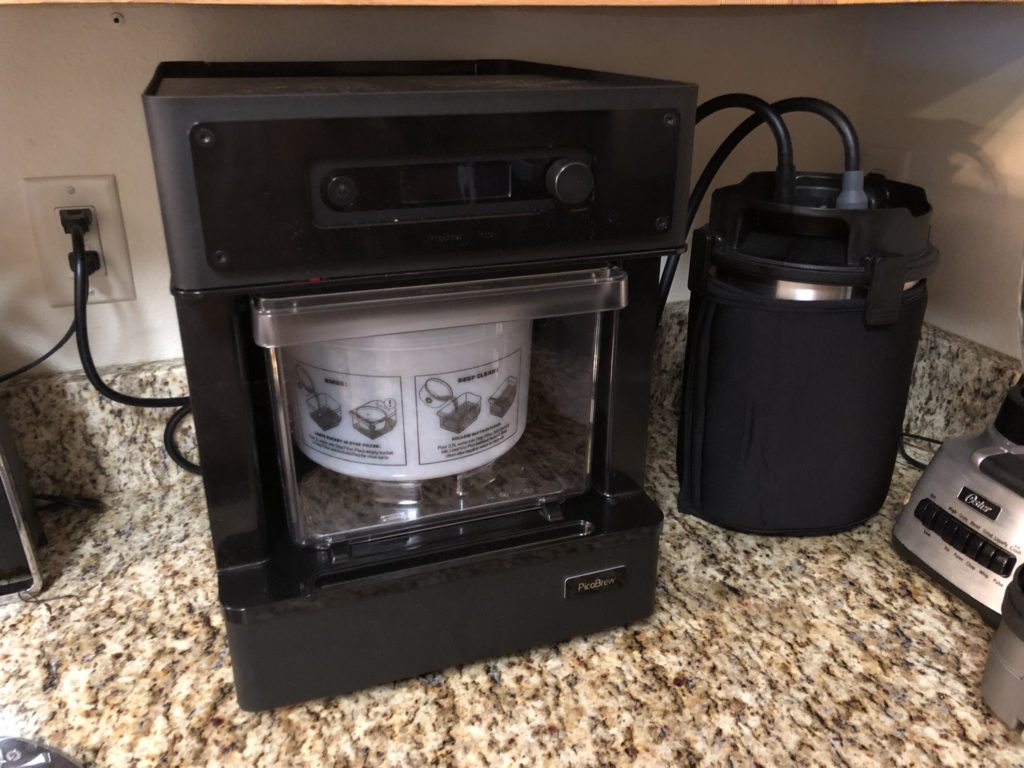
Welcome to the Tosche Station Brew House, a new ongoing blog series (with HEAVY inspiration taken from one of my favorite video series in Acquisitions Intoxicated) and soon to be podcast where we’re going to be taking a Star Wars character, event, or thing, and crafting a beer around them. Those of you who own a Picobrew system will be able to plug the recipes created into the Freestyle PicoPak maker or blank PikoPak (more on that in a moment) to make these beers yourself in the comfort of your own home. Up first, we’re cooking up a beer all about the snarkiest gun in the Galaxy Far, Far Away: Sinjir Rath Velus. To the jump!
Full disclosure at the beginning: I am a total amateur who has no idea what I’m doing. I’ve got only the barest knowledge of ingredients and process at this point, so you’re going to be learning along with me.
So question the first: What kind of beer would be appropriate for a Sinjir? To answer that question, we hop over to Picobrew’s Freestyle PicoPak designer. What are PicoPaks? These are the storage and brewing vessels for the hops and grains that are going to formulate the wort, the pre-fermented liquid extracted from said hops and grains that will serve as the basis for your beer. Over at the Freestyle designer, you can select a base recipe to serve as a starting point. These are starting points, something like a stout, an American IPA, a Saison, or a hazy for example. Now, let’s think about Sinjir. What sort of a beer would he be having? In polling Twitter, the three most popular results were an American IPA, a hazy, and a Saison.
Okay, we’ve got three possibilities, but let’s narrow them down further. Selecting how strong the beer should be will have an impact on what style we want to start with as a base. Back to Twitter, I asked if I should go with a 6.5% ABV, a 7%, a 7.5% or an 8%. And let’s see what the-
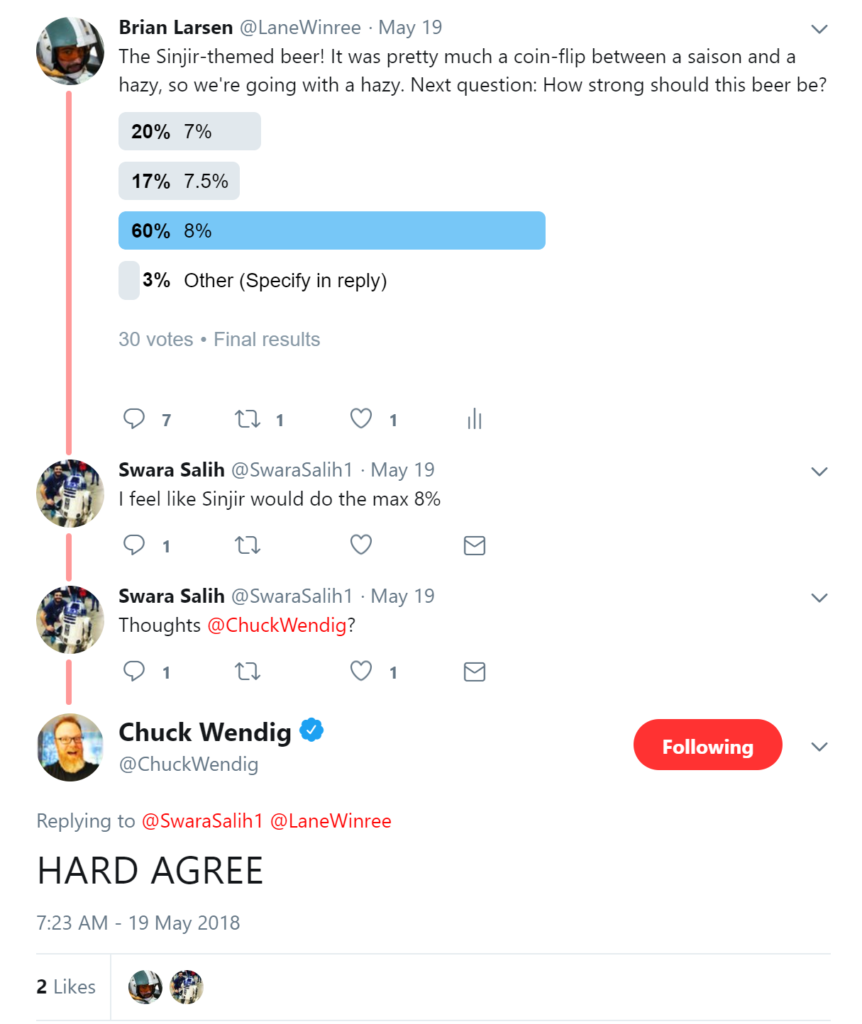
Well who am I to disagree with that? 8% ABV or above it is! Now we head off to the Freestyle designer. Reminder: this process was pretty new to me. Initially I was working with a hazy base recipe that won the initial Twitter poll, but the designer wouldn’t quite allow me to take it over a 7.5% ABV. With that in mind, I shifted over to my personal first choice in an American IPA. Let’s start customizing!
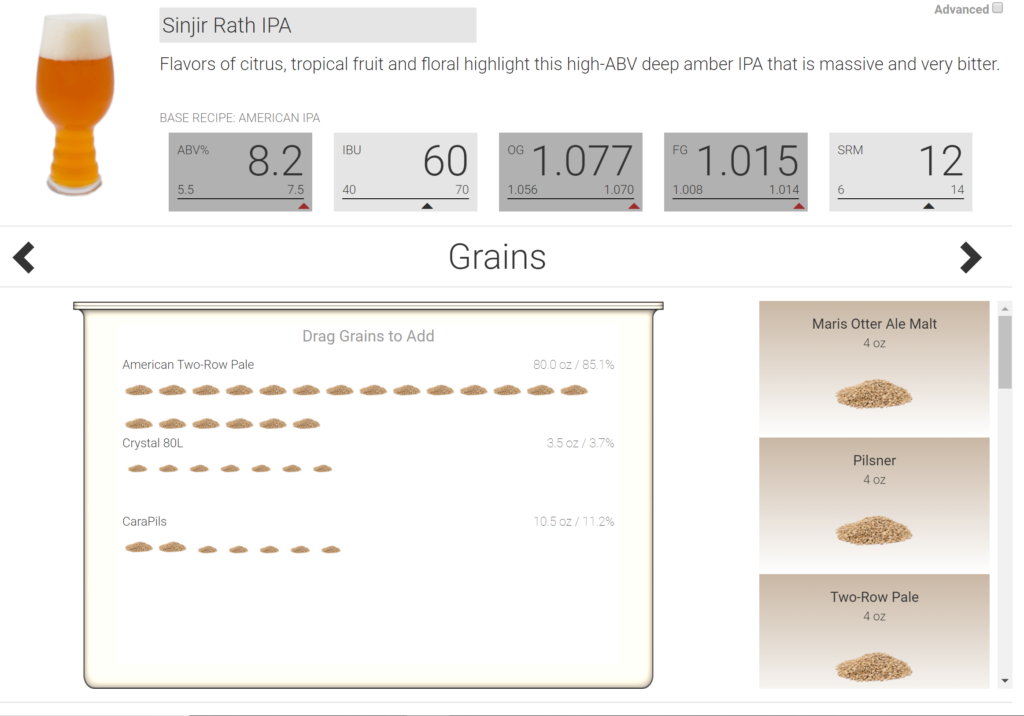
Welcome to the grains screen. Just like you’d suspect, on this screen you can customize the grains you’ll add to your brew. Up at the top you’ll notice five sets of numbers.
- The first is ABV (Alcohol by volume) percentage. Higher the number, stronger the beer.
- Next is IBU, or International Bittering Units. This is going to govern, obviously, how bitter your beer is. Higher number, more bitter the beer
- OG stands for Original Gravity. The description per RealBeer.com: This is the specific gravity of the unfermented wort. The primary contribution to specific gravity is sugar, some of which is fermented into alcohol, and some of which remains in the finished beer to give sweetness and body.
- FG stands for “Final Gravity.” Once again the description per RealBeer: The final gravity is the specific gravity of the fermented beer. It will always be less than the original gravity because during fermentation heavy sugars are converted to lighter carbon dioxide and alcohol. The gravity is reduced both by the reduced sugar content, and because alcohol is lighter than water. Thus the sugar content of the finished beer cannot be calculated directly from the final gravity, without taking the alcohol content into account.
- Finally is SRM. This denotes what the color of your beer is going to be, and you can use this handy chart to help.
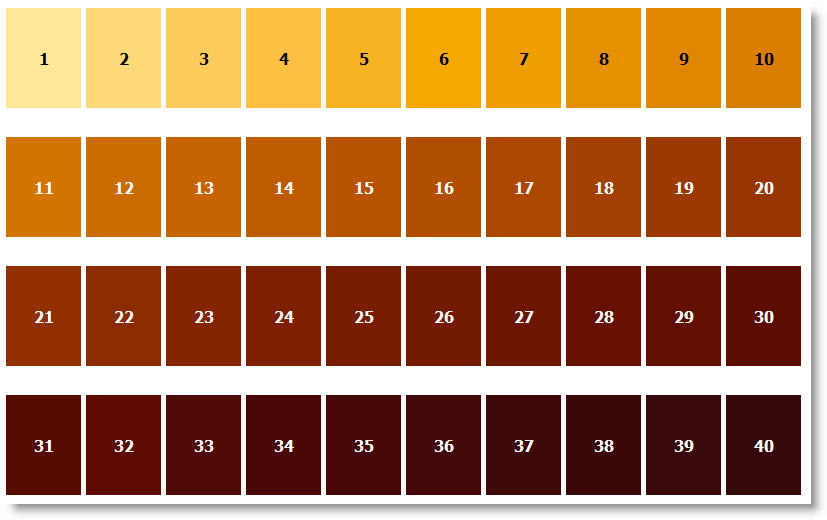
You’ll notice that the Freestyle designer offers a suggested range for each of those values. Good news, they’re merely guidelines! For my part, the numbers I’m paying most attention to are ABV, IBU, and SRM. The American IPA base recipe starts with a baseline of a 6.6% ABV, 55 IBUs, and an SRM of 10. We know we need to crank up the ABV, but we need to make a decision of how bitter this beer should be. For my money, Sinjir would be into bitter beers (because it’s bitter like him). One of my favorite readily available bitter beers is Elysian’s Space Dust IPA. In looking that one up, it’s got an IBU of 60, so I think it’s safe to make the recipe more bitter than what is listed as the base. Now how are we going to get to those targets? Well, here’s what I used:
- 80 ounces of American Two-Row Pale
- 3.5 ounces of Crystal 80L
- 10.5 ounces of CaraPils
Every time you adjust the grains (and the hops later), the description at the top of the screen will adjust to describe the current beer you’ve made. In going with this arrangement of grains, the Freestyle maker lets you know you’re crafting a strong, high 8.2% ABV beer that is very heavy and VERY bitter. Now that we’re satisfied with the grains, it’s time to move on to hops to help flavor the beer.
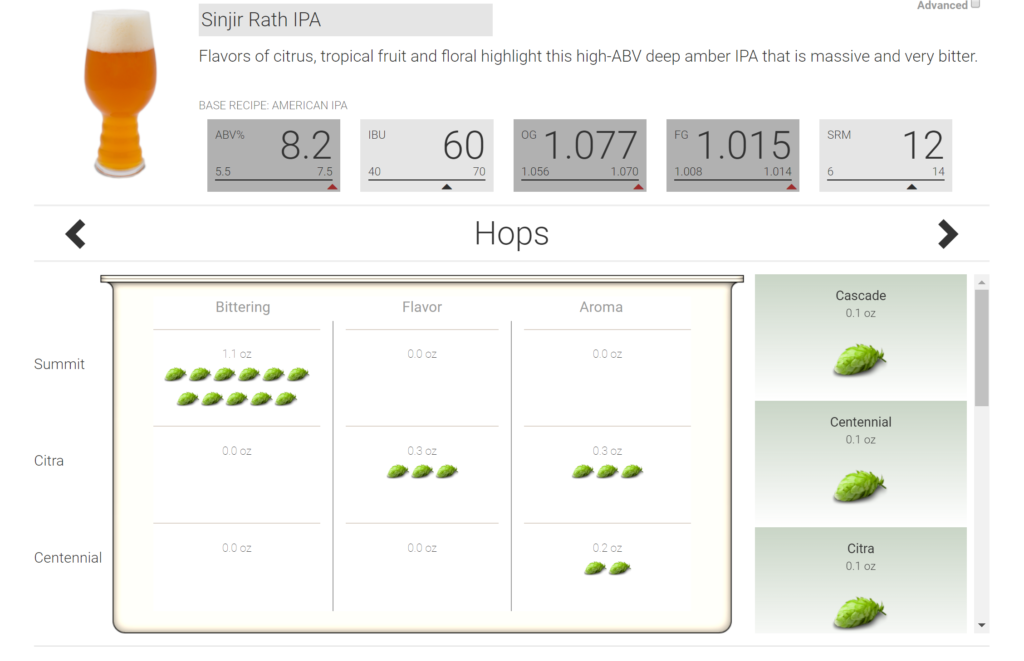
The same idea is in play here. You’ll add hops to modify the flavor and slightly adjust other factors in your beer. For hops, there are three main stages: bittering, flavor, and aroma. These are exactly as they sound. Bittering will govern how bitter your beer is and have a large impact on the IBU value, flavor will impact the taste (and modify the description at the top of the screen), and aroma will impact that whiff you get of the beer. For this beer, I flailed around and settled on…
- 1.1 ounces of Summit as the bittering hop
- .3 ounces of Citra as the flavor hop
- .3 ounces of Citra and .2 ounces of Centennial as the aroma hops
The result of this hops setup gives the beer a bit more of a citrus and fruit element to the taste, and you know what? Sinjir’s good with that, I think. Moving on! Some beers have what is called a Dry Hop phase. These are hops you add to the wort while the beer is fermenting to impart some additional flavors.
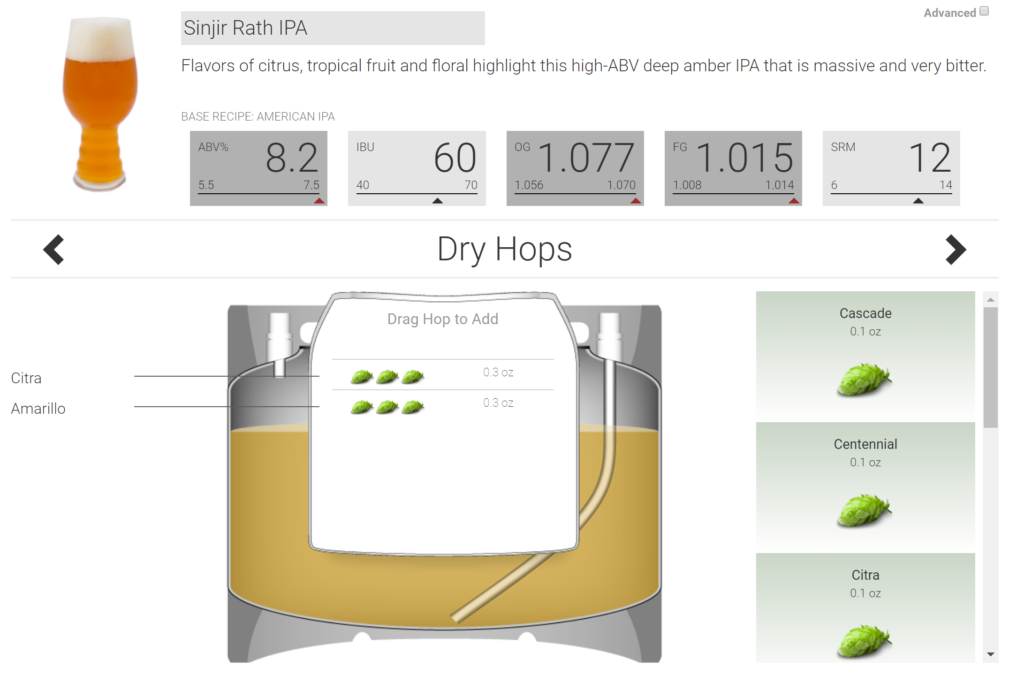
For this, I wanted to add just a touch of sweetness to cut through a bit of how bitter this beer is going to be. I went with…
- .3 ounces of Citra
- .3 ounces of Amarillo
The end result of this is, as the designer describes it, a beer with “flavors of citrus, tropical fruit, and floral highlight this high-ABV deep amber IPA that is massive and very bitter.” Now, I don’t know about you, but that sounds like a VERY Sinjir Rath Velus beer to me. With an ABV of 8.2, an IBU of 60, and an SRM of 12, this is definitely a heavy, strong, copper beer that you’re going to want to nurse.
With the recipe finished, you can now order it and Pico will ship the pack to your house to throw into your PicoBrew appliance. I should also point out that PicoBrew has also recently Kickstartered blank PicoPaks, so you’ll soon be able to also get these ingredients from your local craft brew shop to use in your device in addition to having Pico ship them directly to you.
Let’s recap the ingredients!
Grains
- 80 ounces of American Two-Row Pale
- 3.5 ounces of Crystal 80L
- 10.5 ounces of CaraPils
Hops
- 1.1 ounces of Summit as the bittering hop
- .3 ounces of Citra as the flavor hop
- .3 ounces of Citra and .2 ounces of Centennial as the aroma hops
Dry hops
- .3 ounces of Citra
- .3 ounces of Amarillo
Plug this into the Freestyle PicoPak designer or grab these ingredients from your local craft brew shop when the blank PicoPaks are available and you’ll be able to brew the same Sinjir’s Rath IPA I’m cooking up here.
When the Tosche Station Brew House returns, we’re going to brew this sucker!

